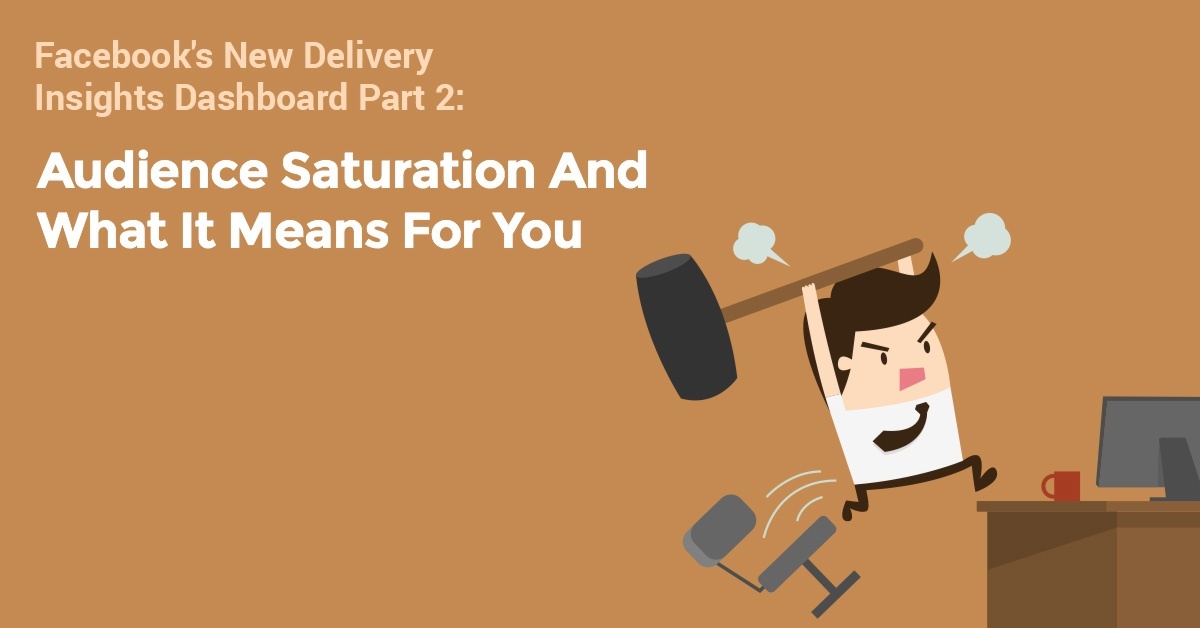As you may know, if you follow Facebook For Business’ blog (or if you’d read the first part of this series), Facebook has recently rolled out their new Delivery Insights Dashboard.
In Part 1 of this series, we covered how to identify and rectify audience overlap. In this post, we’ll be talking about Audience Saturation and what it means for you and your campaigns.

Why Audience Saturation Matters
In the third tab of the Facebook Delivery Insights Dashboard, you’ll see a list of percentages which is the “First Time Impression” ratio, i.e. the % of times on each day your ad was served to people in that specific audience, who have never seen your ad before. 
The fifth column in this Dashboard is the “Audience Reached Ratio” which is the number of people you’ve reached with your ad over the number of total people in that audience, as a percentage…
You may be thinking to yourself at this point “Why should I care?”
If your first time impression ratio is low, this could negatively affect performance because the same people are seeing your ads over and over and over again.
And if they happen to report your ads for running too frequently, then your cost goes up.
Similiarly, if your audience reached ratio is high, it may be time to test new interests, or refresh your lookalike audiences with a newly uploaded list, or do a creative test.
Here are a few ways to fix that:
Use Case 1
You open up the Audience Saturation tab in your Delivery Insights dashboard and find your first time impression ratio is high…
Here are a couple of solutions:
If you’re running video ads, create a separate video engagement audience made up of everyone who has viewed your ad. Then exclude that audience from the adset with the original video ad.
Similiarly, use “utm_term” parameters to tag your conversions and make a custom audience of people from your original audience who’ve clicked your ads. Then exclude the custom audience from the original adset.
Use Case 2
If your first time impression ratio is low, and your budget and/or bid is low, you either need to increase your bid (bidding your true value as Facebook calls it), or test new creative to be able to reach more people (and scale your campaign).
If you’re already bidding as much as you can and you still want to scale your campaigns, you’ll need to raise your CTR, your relevance score, your page conversion rate, or all the above to reach more people in your key, converting audiences. To determine how much you can actually pay per lead and per customer, use FunnelDash’s Facebook Optin LTV Dashboard.
Remember, when you’re bidding for conversions on Facebook, your total bid is a combination of what you tell Facebook a conversion is worth to you, plus your expected landing page conversion, expected click thru rate, and other relevance factors (positive feedback and negative feedback).
Use Case 3
If your audience reached ratio is high, I would try using the interest expansion option for your interest targeting (check box below that says “expand interests when it may result in a lower cost per conversion),
Or try targeting lookalikes from custom audiences that update themselves regularly. Lookalikes with a seed of site visitors or leads, will regularly change as you continue to run traffic, thus adding new people into your audiences and reducing the risk of high frequency/saturation.
Another solution in this case would be to set up automated custom audiences using one of the various solutions out there
Keeping Your Brand And Your Campaigns Healthy, Long Term
While many direct response marketers have a mindset of “if it’s ain’t broke don’t fix it”, or more accurately, “if it’s still converting, don’t change it”, it’s important to take the necessary steps to keep your campaigns (and your brand) healthy before everything falls apart.
Follow the steps outlined in this post and you’ll be able to avoid costly negative feedback on your ads due to high frequency and saturation, and reach new prospects on a predictable and consistent basis.
Get a Better Look at How This Works
We’ve created an infographic for you, that we’re calling, “Have Your Facebook Ads Reached the Saturation Point?” It’s got each of these Use Cases diagramed out for you.
Print it out and keep it by your desk, so you have a handy reference guide when you need to increase your audience reach. Click on the button below to get the infographic.
How do you prevent audience saturation in your campaigns? Tell us in the comments.


